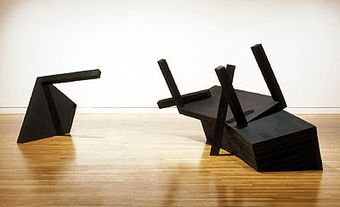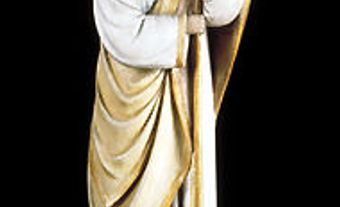Hahn, Emanuel Otto
Emanuel Otto Hahn, sculptor (b at Reutlingen, Württemburg, Germany 30 May 1881; d at Toronto 14 February 1957). In July 1888 he emigrated with his family to Toronto where he spent most of his life. He studied modelling and commercial design at the Toronto Technical School and Ontario College of Art and Industrial Design (c1899 -1903). In 1901 he was hired by the McIntosh Marble and Granite Company, for whom he designed the bronze reliefs on the Robert Burns Monument, Allan Gardens, Toronto (1902), and by 1903 was working for the Canada Foundry Company, Toronto. In November 1903 he left for three years in Europe. Residing with family in Stuttgart, Germany, he studied art and design at the local Kunstgewebeschule (School of Art and Design) and the Technische Hoschule (Polytechnical School), and briefly apprenticed in the studio of a sculptor attached to the Kunstacademie.
Returning to Toronto in August 1906, Hahn began working on contract as a monument designer for the Thomson Monument Company, a professional association lasting for over forty years. From early 1908 to June 1912 he also worked as a studio assistant to the sculptor Walter S. Allward, helping in the realization of Allward's South African Monument (Toronto), the Alexander Graham Bell Memorial (Brantford) and the Baldwin-Lafontaine Monument (Ottawa). In 1912 he was appointed as the modelling instructor at the Ontario College of Art, eventually heading the sculpture department until his retirement in 1951.
It was in the years immediately following the First World War that he established himself as one of the leading sculptors in English Canada, initially on the strength of his designs for Canadian war memorials and civic monuments. A notable event in his early career was his winning of the 1925 Winnipeg Cenotaph Competition, which, because of his German origins, created a major public controversy. In due course the controversy lead to the loss of the commission, but catapulted him nonetheless to national attention. In 1926 he was awarded the contract for the Edward Hanlan monument, erected on the Canadian National Exhibition grounds in Toronto, and in 1929 won the competition for a memorial to Sir Adam Beck, his most important monumental project, unveiled in 1934 on University Avenue, Toronto.
Hahn made his exhibition debut at the 1904 exhibition of The Arts and Crafts Society of Canada with the models for his Robert Burns panels. He first exhibited with the Ontario Society of Artists in 1907, and with the Royal Canadian Academy of Arts in 1908, becoming a regular exhibitor in the annual shows of both arts societies. In 1927 he was elected an associate of the Royal Canadian Academy of Arts, and was made a full academician in 1931.
A charter member of the Arts Letters Club of Toronto (established 1908), he also served as the first President of the Sculptors' Society of Canada, which he co-founded in 1928 with Frances LORING, Florence WYLE and Elizabeth WYN WOOD. The exhibitions of the SSC provided another important means of publicly displaying his smaller independent sculptures, as well as models for public monuments. His earliest independent sculpture of note, and the first to be realized in bronze, was Indian Scout (1913). Its purchase in 1917 by the National Gallery of Canada helped build Hahn's reputation as an academic sculptor.
Opportunities to view more progressive forms of modern sculpture in Toronto in the 1920s, and his relationship with the much younger sculptor Elizabeth Wyn Wood, whom he married in 1926, stimulated changes in Hahn's personal style in the later 1920s. His 1926 marble portrait bust of Elizabeth Wyn Wood and Flight of 1928 (location unknown) represent his finest work in a modern, streamlined style. Excelling as a portraitist, his 1929 Head of Vilhajalmur Stefansson (National Gallery of Canada) won him the 1930 Willingdon Prize. He was also notable as an applied artist, enjoying enduring fame for his Canadian coin designs, including the "Voyageur" silver dollar of 1935, and the 1937 "Caribou" twenty-five cent and the ten-cent "Bluenose" coins.

 Share on Facebook
Share on Facebook Share on X
Share on X Share by Email
Share by Email Share on Google Classroom
Share on Google Classroom


